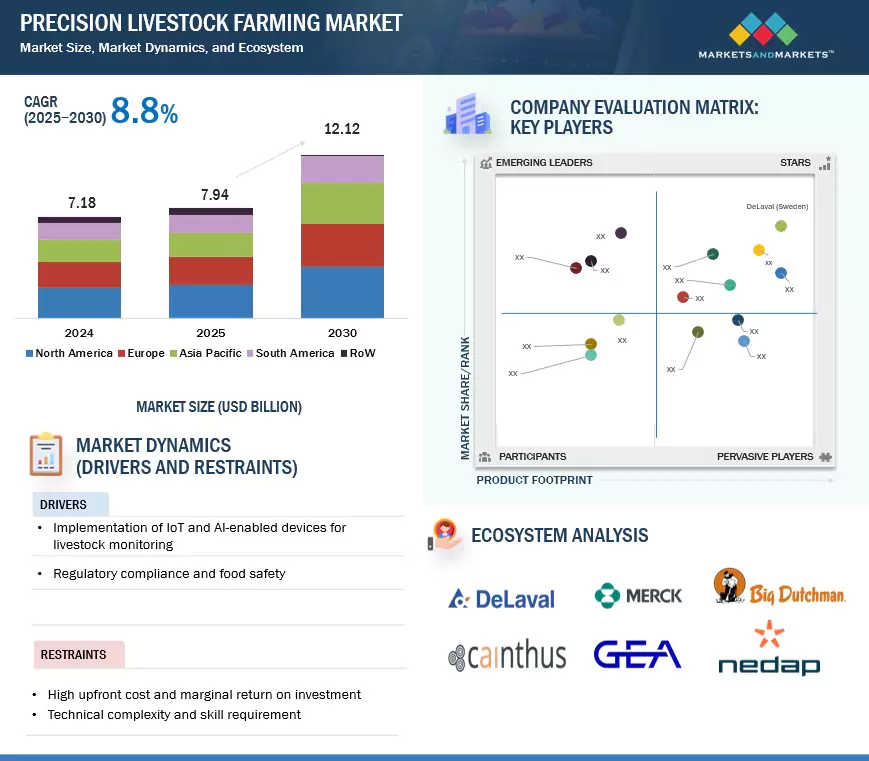According to a precision livestock farming market report by MarketsandMarkets, the industry is set to grow from USD 7.94 billion in 2025 to USD 12.12 billion by 2030, at a robust CAGR of 8.8%. The global precision livestock farming industry is entering a new growth era, fueled by the convergence of automation, digitalization, and rising demand for sustainable animal farming.

Farmers across dairy, swine, and poultry sectors are adopting robotic milking systems, precision feeding solutions, and advanced livestock monitoring to maximize yields, reduce costs, and improve herd health. Industry leaders like Lely, MSD Animal Health, DeLaval, and GEA Group are actively shaping this transformation within the broader livestock market.
Milk Harvesting: Leading Application Segment
Milk harvesting is projected to hold a significant share of the precision livestock farming market during the forecast period. Automated milking systems are revolutionizing dairy operations by:
- Enabling flexible milking schedules
- Ensuring consistent milk quality
- Providing real-time udder health monitoring
- Reducing labor dependency
With global dairy demand rising, automated solutions are helping farmers achieve higher efficiency, improve animal welfare, and optimize profitability.
Dairy Farms: Major Growth Drivers
Dairy farms are expected to remain the largest adopters of precision solutions. From robotic milking and automated feeding to real-time animal health tracking, these systems are transforming operations and boosting efficiency. The adoption of next-gen automation and monitoring tools enables farmers to detect early signs of illness, optimize resources, and improve yields.
Address Your Business Needs with Bespoke Data Solutions
North America: Leading the Way
North America is forecast to hold the largest market share, thanks to its strong agricultural infrastructure and high adoption of digital technologies. The region’s farms are already leveraging IoT-enabled devices, RFID systems, and advanced data analytics for improved decision-making and operational efficiency.
This aligns with the broader trend of data-driven, sustainable livestock production that enhances traceability and aligns with consumer and regulatory expectations.
Key Market Players
Some of the major companies shaping the precision livestock farming landscape include:
- DeLaval (Sweden)
- GEA Group (Germany)
- Afimilk (Israel)
- Merck & Co., Inc. (US)
- Nedap N.V. (Netherlands)
- Lely International (Netherlands)
- Waikato Milking Systems (New Zealand)
- Livestock Improvement (New Zealand)
- Boumatic (US)
- Fancom B.V. (Netherlands)
Frequently Asked Questions
Q1. What is precision livestock farming?
It refers to the use of automation, IoT, and analytics to improve herd management, productivity, and welfare. Farmers benefit from reduced costs, early disease detection, and improved efficiency.
Q2. What does the livestock market size look like by 2030?
The livestock market size is growing steadily, with precision livestock farming contributing significantly through automation, monitoring systems, and sustainability-focused technologies.
Q3. Which application dominates the precision livestock farming industry?
The milk harvesting application is expected to dominate, thanks to automated milking systems that increase yield, efficiency, and herd health.
Q4. How is digitalization shaping farming?
The digital livestock farming market is expanding rapidly as farmers adopt RFID, IoT-enabled monitoring, and AI-powered analytics to make data-driven decisions.
Q5. Which region leads the adoption?
North America is expected to hold the largest share, supported by advanced infrastructure, commercial farm scale, and strong adoption of automated solutions.
Q6. Which farm equipment is gaining traction?
The livestock farm equipment market is seeing demand for robotic milking systems, automated feeding tools, and health monitoring sensors that help farmers cut labor costs and improve yields.